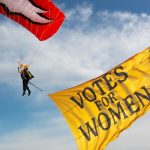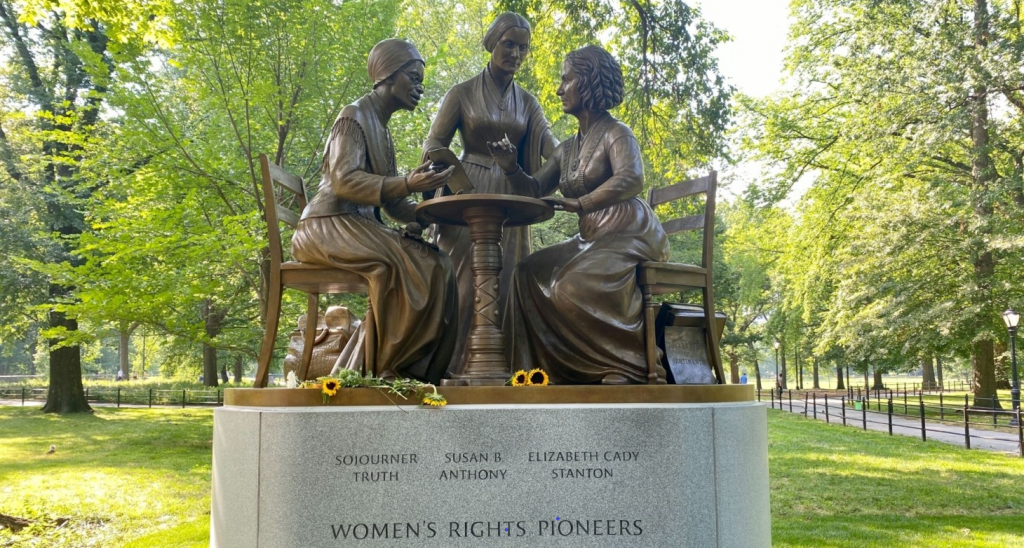It has taken me a year to come to grips with my sadness over the women’s suffrage centennial.
Like Ellen Goodman and Lyn Scherr, I expected “confetti and cocktails, triumphant gatherings of women and men. White pantsuits and a red rose. A national shout-out to three generations of [brilliant, visionary, heroic] suffrage leaders.”
But the centennial didn’t quite turn out that way.
 Yes, we got a stunning tribute by an all-woman skydiving team. We got long overdue recognition of Black, Latina, Asian and Native American suffragists, and long overdue statues and memorials. But we also got dull exhibits and the incessant drip-drip-drip of the double standard of history. There was no Google Doodle on August 26, 2021.
Yes, we got a stunning tribute by an all-woman skydiving team. We got long overdue recognition of Black, Latina, Asian and Native American suffragists, and long overdue statues and memorials. But we also got dull exhibits and the incessant drip-drip-drip of the double standard of history. There was no Google Doodle on August 26, 2021.
The general mood was “Meh, there’s nothing to celebrate; it’s just women”, even though this momentous accomplishment resulted in the largest increase of voters in American history and paved the way for numerous feminist achievements.
Goodman and Sherr blamed the disappointing centennial on COVID and the so-called Cancel Culture.
However, the pandemic did not stop Black Lives Matter from marching in the streets after the George Floyd murder. It did not keep Juneteenth from becoming a national holiday. It certainly didn’t halt the insurrectionists at the Capitol.
Likewise, the Cancel Culture has not kept conservatives from viciously attacking Critical Race Theory and Forget the Alamo and shamelessly using them as political dog whistles.
The women’s suffrage centennial was a disappointment—a box office flop—because of the double standard of history and feminist historians’ refusal to openly challenge it.
When Brent Staples wrote “How the Suffrage Movement Betrayed Black Women” for The New York Times (NYT) in 2018, I immediately asked several women’s history groups, “How are you going to respond to this double standard? He has NEVER written articles about how the abolitionist and civil rights movements betrayed women.”
Most of them said, “We’re going to dialogue with the media and civil rights groups.”
 Obviously, those “dialogues” didn’t work. It seemed like every major news outlet, from NYT to Smithsonian to The Atlantic, was determined to emphasize that WHITE SUFFRAGISTS WERE RACISTS–and continue to give Frederick Douglass and Martin Luther King a pass on their sexism.
Obviously, those “dialogues” didn’t work. It seemed like every major news outlet, from NYT to Smithsonian to The Atlantic, was determined to emphasize that WHITE SUFFRAGISTS WERE RACISTS–and continue to give Frederick Douglass and Martin Luther King a pass on their sexism.
The final slap came when the NYT editorial board stated on August 15, 2020 that “it is morally repugnant and counterproductive to mythologize [the 19th Amendment] as a triumph of egalitarianism.”
And how did women’s history and feminist groups respond to that kick in the teeth?
Silence. Subservient silence.
True, numerous NYT subscribers objected to both the Staples’ article and the NYT editorial.
A few feminists wrote rebuttals. Monumental Women co-founder Myriam Medzian wrote a strong dissent. The novelist Robin Morgan wrote a thoughtful trilogy of critical meditations (See Parts 1, 2, and 3). Journalists Goodman and Scherr reminded us of the repulsive historical fact that the NYT was strongly against women’s suffrage.
But the media does not respond to voices in the wilderness. The media responds to movements. So why didn’t we have a movement?
Feminist historians have an impressive track record of standing up to patriarchy. Susan B. Anthony historians vigorously pushed back the notion that “Miss Anthony” was an anti-abortion activist. Women’s Rights Historical Park would have never existed without the insistent activism of the National Women’s History Project. The National Woman’s Party made sure in the 1960s that Congress did not turn the Ava Belmont House (now a national monument) into an office building.
So why were they so silent about the double standard during the Centennial?
I hate to say it, but it’s because of internalized misogyny. I have been to all types of historical commemorations and at women’s suffrage celebrations, they don’t show the same “THEY WERE GIANTS!” pride that happens at Veterans Day and Martin Luther King Day events. They’re much too ladylike.
In a similar vein, most suffragist websites are too modest. The Alice Paul and Ida B. Wells sites would have praised these all-time great activists a hundred times more if they had been men.
Even the Elizabeth Cady Stanton site, which rightly calls her brilliant and revolutionary, doesn’t give her all the credit she deserves. The site should have quoted Joan Bradley Wages, who said in an October 16, 2016 email to National Women’s History Museum subscribers:
“Make no mistake — the immensity of [Elizabeth Cady Stanton’s] contribution deserves more than a footnote. If our nation’s ultimate creed is ‘equality,’ then she belongs on the same list as Abraham Lincoln, Martin Luther King Jr., Thomas Jefferson, and Frederick Douglass.”
 Women’s history groups need to vigorously stand up to the double standard NOW.
Women’s history groups need to vigorously stand up to the double standard NOW.
When I said that to a history professor, she assured me in carefully measured tones that when she tells her students the WHOLE complicated story of misogyny, racism and suffrage, they realize that the media coverage is imbalanced. And they become deeply convinced when she quotes Kimberle Crenshaw’s statements about the intersectional failures of Martin Luther King and the Civil Rights movement.
She reminded me of the days when suffragists were lambasted for supporting temperance. Because of decades of quiet consciousness-raising (with reminders that most male progressives, including Frederick Douglass, were pro-temperance), that sort of abuse has subsided.
However, women’s history advocates need to do more than be patient and educate, especially since some of us felt betrayed because they didn’t fight for suffragists when they got attacked.
Suffrage historians must challenge the double standard of history immediately with as much force as the #MeToo and anti-Confederate statues activists. And they must stand up to the inevitable pushback.
There is no excuse for silence. The brilliance and sacrifices of the suffragists must never be forgotten, trivialized, or exploited. They deserve as much respect as abolitionists and Civil Rights activists.
These early feminists were GIANTS.


